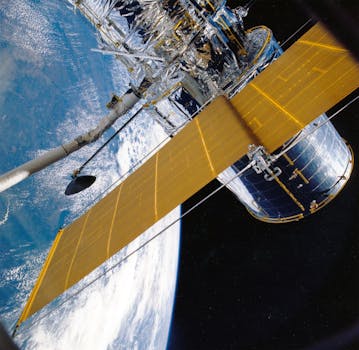Orbiting Innovations: Key Updates in Satellite Telecommunications Technology

Orbiting Innovations: Key Updates in Satellite Telecommunications Technology
Orbiting Innovations: Key Updates in Satellite Telecommunications Technology is transforming the way we communicate, with satellite telecommunications playing a vital role in this transformation. The satellite telecommunications industry is experiencing a surge in innovations, with key updates in technology and services. In this article, we will explore the latest developments in satellite telecommunications technology, including advancements in satellite constellations, 5G integration, and cybersecurity.
Advancements in Satellite Constellations
Satellite constellations are a network of satellites that work together to provide global coverage and connectivity. Recent advancements in satellite constellations have led to the development of smaller, more efficient satellites that can be launched at a lower cost. This has made it possible for companies to launch large constellations of satellites, providing global coverage and connectivity. One of the key players in this field is SpaceX, which has launched over 1,000 satellites as part of its Starlink constellation. Other companies, such as Amazon’s Kuiper Systems and OneWeb, are also developing their own satellite constellations.
5G Integration
The integration of 5G technology with satellite telecommunications is another key area of innovation. 5G technology offers faster data speeds and lower latency, making it ideal for applications such as video streaming and online gaming. Satellite telecommunications companies are working to integrate 5G technology into their networks, allowing for seamless connectivity between satellite and terrestrial networks. This will enable users to access 5G services from anywhere in the world, even in areas where terrestrial networks are not available.
Cybersecurity
Cybersecurity is a critical concern for the satellite telecommunications industry, as satellite systems can be vulnerable to cyber threats. Recent advancements in cybersecurity have led to the development of more secure satellite systems, including the use of encryption and secure communication protocols. Companies are also developing new technologies, such as artificial intelligence and machine learning, to detect and respond to cyber threats. The use of these technologies will help to protect satellite systems from cyber attacks and ensure the integrity of satellite communications.
Other Innovations
In addition to advancements in satellite constellations, 5G integration, and cybersecurity, there are several other innovations in the satellite telecommunications industry. One of the key areas of innovation is the development of new satellite technologies, such as quantum satellites and satellite-based earth observation systems. Quantum satellites use quantum entanglement to secure communication, while satellite-based earth observation systems use satellites to collect data on the environment and climate change. These technologies have the potential to revolutionize the way we communicate and understand our planet.
Another area of innovation is the use of satellite telecommunications for emergency response and disaster relief. Satellite communications can provide critical connectivity during emergencies, allowing first responders to communicate and coordinate their efforts. Satellite telecommunications companies are working to develop new technologies and services that can support emergency response and disaster relief efforts, including the use of satellite-based emergency position-indicating radio beacons (EPIRBs) and satellite-based cellular networks.
The satellite telecommunications industry is also experiencing a surge in innovations in the area of satellite manufacturing and launch. New technologies, such as 3D printing and reusable launch vehicles, are making it possible to manufacture and launch satellites at a lower cost. This has led to an increase in the number of satellites being launched, with many companies launching large constellations of satellites. The use of these technologies will help to make satellite telecommunications more accessible and affordable for people around the world.
Conclusion
In conclusion, the satellite telecommunications industry is experiencing a surge in innovations, with key updates in technology and services. Advancements in satellite constellations, 5G integration, and cybersecurity are transforming the way we communicate, while other innovations, such as quantum satellites and satellite-based earth observation systems, are opening up new possibilities for the use of satellite telecommunications. As the industry continues to evolve, we can expect to see even more exciting innovations and developments in the years to come.



